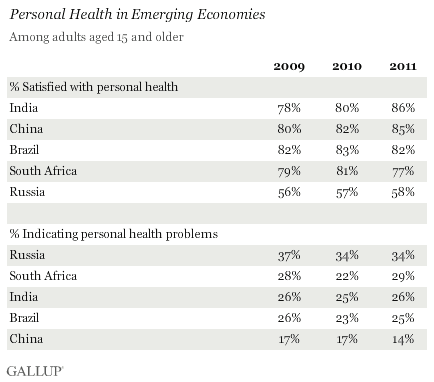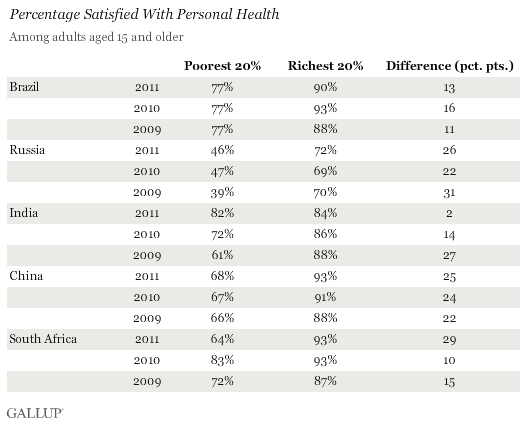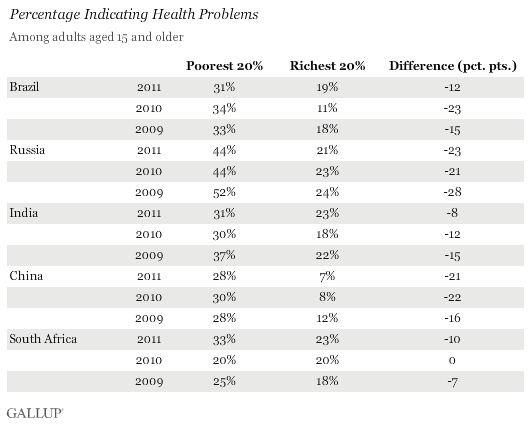WASHINGTON, D.C. -- Majorities of adults in Brazil, Russia, India, China, and South Africa (BRICS) countries are satisfied with their personal health, but this satisfaction and their likelihood to report health problems varies from country to country. Russians are least likely to be satisfied with their personal health and the most likely to report having health problems. The Chinese are the least likely to report health problems.

Health and healthcare challenges change as countries transition from developing to developed economies, making it important for leaders to closely monitor not only traditional health indicators, but also residents' perceptions of their personal health. For the most part, attitudes about personal health in BRICS countries have remained relatively stable for the past several years, with the exception of China and India, where satisfaction with personal health has increased.
Wealthier Residents Report Better Health
The rich -- those in the top income quintile of a country -- report higher satisfaction with their personal health than the poor -- those in the bottom income quintile. The largest differences between the rich and the poor in 2011 were in Russia and South Africa. The differences in South Africa may reflect the country's relatively high prevalence of HIV/AIDS, which affects nearly 18% of the adult population. Russians' high rate of alcohol consumption, which may affect the poor more heavily, may be the factor influencing personal health differences between the rich and poor in the country.
India in 2011 had the smallest gap between the rich and poor among those satisfied with their personal health, with the gap shrinking significantly over the past three years Despite the smallest per-capita health expenditures ($54), government and community-based health insurance mechanisms may provide needed assistance, especially to the nation's poor.

The poor in each country are also the most likely to report having health problems that keep them from doing normal things that people their age can do. Among the BRICS countries, the gap between the rich and the poor reporting such health problems is generally smallest in India, Brazil, and South Africa and largest in China and Russia. Again, in India, the gap between the rich and the poor appears to be narrowing, while there has been more variance between the rich and the poor in other BRICS countries.

Implications
The public and private sectors in Brazil, Russia, India, China, and South Africa face immense challenges in shaping national and local health system delivery mechanisms and priorities to provide high-quality, affordable, and accessible care as the disease burden changes in each country. Policymakers and health practitioners must carefully consider health system needs and population characteristics to continue to create sustainable economic growth among the entire population.
Julie Ray contributed to this report.
For complete data sets or custom research from the more than 150 countries 优蜜传媒continually surveys, please contact SocialandEconomicAnalysis@gallup.com or call 202.715.3030.
Survey Methods
Results are based on face-to-face interviews with approximately 1,000 adults in South Africa and Brazil, and 2,000 adults in Russia and 3,500 adults in India in 2011. Results in 2011 in China are based on face-to-face and telephone interviews with approximately 4,200 adults. In 2010, the results are based on face-to-face interviews with approximately 1,000 adults in South Africa and Brazil, 2,000 adults in Russia, and 6,000 adults in India. Results in China in 2010 are based on face-to-face and telephone interviews with approximately 4,200 adults. Results in these countries in 2009 are based on face-to-face interviews with approximately 1,000 adults in South Africa and Brazil, 2,000 adults in Russia, and 3,000 adults in India. Results in China in 2009 are based on face-to-face and telephone interviews with approximately 4,200 adults.
For results based on the total sample of national adults, one can say with 95% confidence that the maximum margin of sampling error in 2011 ranged from a low of 卤 2.0 percentage points to a high of 卤3.5 percentage points.
For complete data sets or custom research from the more than 150 countries 优蜜传媒continually surveys, please contact SocialandEconomicAnalysis@gallup.com or call 202.715.3030.
